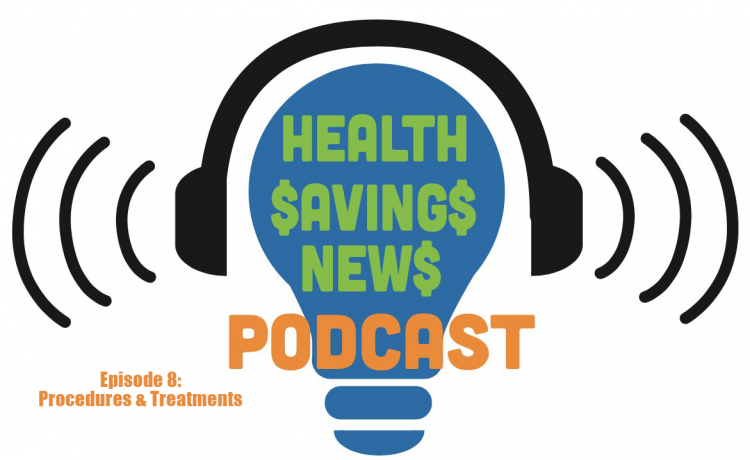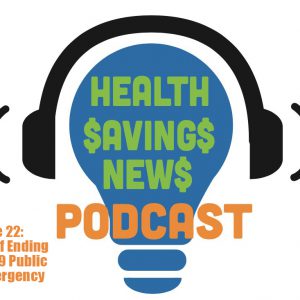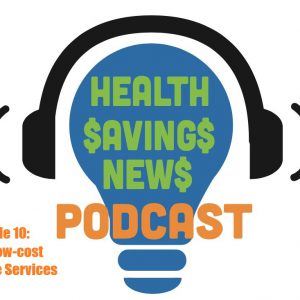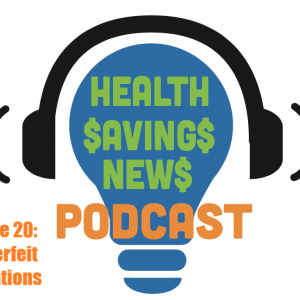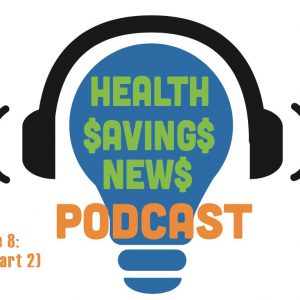This a transcript to episode 9 of Health Savings News. In the interest of making the podcast more accessible, we will post transcripts every two weeks as episodes release.
Evan (00:10):
Hello, and welcome to Health Savings News: the podcast about healthcare costs in America and how to save money on the often expensive care all kinds of people need. I’m your host, Evan O’Connor, joined by retired doctors, Rich Sagall and Mike Woods. Each episode we discuss healthcare costs in America, offer tips for saving money, and relevant news that affects and reflects the expensive landscape of healthcare in America.
Today’s topic is procedures and treatments. Annual wasteful spending on healthcare is estimated from $760 billion to nearly a trillion, including estimated from 75 billion to over 101 billion from overtreatment or low value care. Overtreatment refers to interventions that do not benefit the patient or where the risk of harm from intervention is likely to outweigh any benefits the patient will receive. It can account for up to 30% of healthcare costs and is increasingly recognized as a widespread problem across nations and within clinical and scientific communities. There are a number of interrelated factors that drive over treatment, including the expanding definition of diseases, advertising and influence from the pharmaceutical industry, how doctors are trained and remunerated, demands from the patients and their families, and the fear complaints leading to doctors to practice defensively.
Mike (01:20):
We’ve discussed in previous podcasts about trying to recognize unnecessary testing visits and ways to cut back on those expenses. And this podcast will be devoted specifically to doing the same thing for procedures, whether they be for treatment or testing. Like other things in testing, yhe procedures are expensive. Prices can vary significantly even for the same procedure. And in many cases, even more than you would have found with testing. Like the testing that we’ve discussed previously, reducing the procedure costs involves both recognizing and avoiding unnecessary inappropriate or excessive procedures and looking for the least expensive option for the procedure. You will find however that this is a much more complicated process than we discussed with the testing.
Rich (02:17):
It’s also a difficult process because many people don’t wanna bring these things up because the physicians might feel their judgment is being questioned.
Mike (02:27):
Exactly. Unnecessary, or as Evan termed it, low value care has always been a part of medical care. In fact, it wasn’t until recently — perhaps the past couple of decades — that researchers have begun to use evidence-based information to look more closely at the effectiveness of many of the practices that have been — I hate to say it — ingrained into medical providers for generations. And once they started looking into this, it quickly became obvious that there were many, many ineffective or even harmful procedures that were still being carried on by physicians. This led to the founding of an organization called Choosing Wisely 10 years ago, which has devoted its time to evaluating the evidence in making recommendations to discontinue many of the practices that were commonplace. As a matter of fact, the COVID epidemic has actually supported this issue. During the epidemic, there was a marked decrease in primary care or hospital and emergency visits, and low and behold it had very little effect on our medical health. So the obvious conclusion was the same that has been come to by the researches is that a lot of the medical care receive can be done without or perhaps delayed to see if the condition would’ve resolved on its own. This even includes elective surgeries. So going forward, experts are convinced enough now that they’re attempting to turn this evidence-based information into recommendations that hopefully can reduce the value of low value care in the long run.
Rich (04:14):
I think an example of what we’re talking about might be beneficial. When I was doing occupational medicine, I remember a fellow I saw who had a knee problem, had an MRI and was scheduled for surgery, but the problem was his blood pressure was outta control. It took a couple of months to get his blood pressure under control. And by then his symptoms were totally gone. His knee was functioning at a hundred percent and he never had the surgery.
Mike (04:39):
Exactly. Let’s see why this kind of happens. I mean, why do physicians and other healthcare providers continue to do these practices? Number one we’ve discussed in the past is that there’s a general inertia that goes along with trying to change anything, any established routine. Physicians and healthcare providers are certainly not free from that particular thing as well. In a lot of cases, being a provider is a very, very busy situation where you’re inundated with patients and medical records and drug reps and all, all sorts of meetings and everything else. So a lot of times providers just don’t have the time to keep track of changes in their specialty and are unaware of current universal guidelines, best practices, or other options to things that they’ve done on a regular basis. They just keep going as they always have. And…
Rich (05:41):
That’s what they learn to do in medical school and residency, and they just continue with it.
Mike (05:46):
Now, sometimes unnecessary procedures are come for other reasons. For example, we talked about this last time, that if you do unnecessary testing or tests are either inaccurate or overread, you could end up with a procedure that you never needed in the first place and would never have been brought up if you hadn’t had the test to begin with. The same thing goes with misdiagnosis. A lot of times people get procedures for diagnosis that’s either inaccurate or is an over-diagnosis. We see that commonly with some forms of cancers where a pathology is read as something that is more malignant than it really is, and you result in cancer treatment that you didn’t really need. People approaching the end of life frequently face a situation of looking carefully at their treatments and whether they’re necessary. This involves either futile treatments that aren’t going to improve your quality of life or treatments that you no longer need approaching the end of life, such as blood pressure medications or cholesterol medications. Our new website Plan for Passing On has a section that goes into this issue of treatment when approaching the end of life in much more detail. www.planforpassingon.org — “planforpassingon” all one word.
Rich (07:15):
Another reason for unnecessary testing, which I’m sure Mike has seen in his practice, is patient pressure or patient preference, where the patient comes in and wants a test done. When– again, when I was doing the occupational medicine, I would see lots of people with back pain and except for very few rare situations, no test makes any difference with back pain. But people wanted an x-ray, a CT, or an MRI, and you get into a difficult position because, you know it’s not gonna make any difference, particularly in acute back pain. Except as I said, for a few situations, particularly cauda equina syndrome, which is very rare and is not back pain, but has other symptoms, including loss of control of bowels and urine.
Mike (07:57):
I have my own personal example where I had a skin cancer on my neck, which was a squamous cell, which aren’t particularly malignant. The dermatologists are in the habit of doing something called a Mohs procedure, which is where they do a biopsy of the lesion to make 100% sure that that’s what they’re dealing with. I actually almost got in an argument with the dermatologist because she was 99% sure nd I was comfortable with that, and I eventually was able to talk her into just removing the lesion rather than going through the incredibly added expense of having a biopsy, waiting, coming back in for another visit and having the lesion removed. When asked why she wanted to do that it was the stable answer that we all loathe: “We always do it this way.” Unfortunately, there are some things about doing excessive procedures that are not so good, such as when physicians or providers have financial interest in what they’re doing. So for example, doing a unnecessary procedure for financial gain, you know, they need money for college for their kids so they decide to do a procedure that’s not truly necessary, but you know, they’re getting paid for it; or doing a specific procedure because they have financial interest in the manufacturer of the treatment device or other company. In a rare occasion you’ll see it done for the convenience of the provider. A good example of that would be C-sections when obstetricians no longer have the patience to await a vaginal birth and want to do a C-section to just get the delivery done.
Rich (09:51):
Another example of that would be the orthopedist, for example, who has an x-ray machine. Now you could say they do the x-ray because they want to get it done, they feel it’s important for treatment, and it’s much more convenient for the patient and the physician and everyone else if they can just go down the hall, get the x-ray and come right back, and you can go over it and see what’s what; versus having the patient go to the hospital or some outpatient facility and the x-ray done. So it’s not always a clear cut situation as to why the test is done and is it of low value.
Mike (10:25):
Yeah, unfortunately, sorting this out is much more difficult than with the previous things we’ve talked about. There are many differences between testing and medications that make the decision about procedures more complicated and difficult. For instance, when it comes to having a procedure done, there are many more options available. There are surgeries that you can have either done as an open surgery or as laparoscopic surgery, such as hernia surgery. You can have procedures done inpatient or outpatient. You can have other different procedural techniques. For instance, with hip replacements, there’s something called a posterior and anterior approach — one is more difficult and therefore more expensive — or the type of anesthesia or sedation you get will impact the cost of the procedure. Procedures have a much higher risk than most other treatments and your preference for what procedure you get becomes much more important. Procedure is more likely based on your level of illness. So, two people with the same surgical condition may have much different costs associated with their surgery because of their level of illness. One may have been much sicker, had a much more complicated surgery, and therefore will have a much bigger bill. as opposed to testing the skill of the provider and the number of procedures they have done comes into play when trying to make a decision about having a procedure done. So when you go to that particular provider, it’s still difficult to know if this is a provider that’s relying on experience: i.e., I’ve always done it this way, or evidence.
Rich (12:15):
Another factor to take into account is what we call the natural course of a disease. And that goes back to what we talked about in previous podcasts, in terms of whether a test or procedure will alter the course of the disease or make participating in the treatment decision making process. So again, talking about back pain: generally, most people with muscular back pain get better in about the same amount of time no matter what you do. So maybe you should just do nothing and give it time. That’s a course of disease, the natural course of disease, what happens no matter what you do. And I think that’s true for many problems, including many orthopedic and joint problems.
Mike (12:51):
Exactly. So what as the patient are you to do about this? Well, the only real solution sometimes is to have the provider go over the most recent evidence for their choices, make them document why they’re doing it this way. You can even do your own research before you go so that you have a good idea of what options are available there. As a matter of fact, a lot of physicians are coming around to this, and there’s a formal procedure in medicine called shared decision making. What that means is that there are different options for either testing or treatment based on the most recent evidence when the choice is not really clear and can only be based on your preferences, your desire to take a certain level of risk, et cetera. There are many specific procedures that have been looked at. We’ve talked previously about a site called Choosing Wisely, which has many pages of information, both for patients and providers about various conditions where currently recommended procedures or treatments may not be needed. There’s also information on certain tests and medications as well. There are a couple of other sources that you can access that will help you determine how necessary a particular procedure is. Two of these are a website called the U.S. Preventive Services Task Force, or a government website called MedlinePlus.
Rich (14:27):
Another website that you might wanna check is the Lown Institute. And they are looking for low value procedures and approaches to healthcare and trying to shape what physicians do, looking for the high value tests, not the low value. I think another thing to keep in mind is that what seems like common sense may not be, and it needs to be proven to actually work. A very common procedure for people with knee problems is to go in and wash out any debris and smooth out the joint with the idea that that would lessen the pain. And it makes sense until somebody — the VA actually tested this, and they did mark surgeries on half a group of people in real surgery. On the other half, the mock surgery involved taking people into the, or preparing to do the incision, do everything, but the actual incision or in some of the tests, they would do incision, but not do the any treatment. And they found three months out the difference in symptoms was negligible.
Mike (15:28):
And unfortunately for me, that study came out after I had that procedure done on myself.
Rich (15:35):
So again, we’re looking back at the natural course of disease.
Mike (15:38):
So now comes down to the important part of the episode is how do you avoid getting unnecessary procedures And are there ways to cut your costs on procedures? As discussed in previous episodes — and we’ve mentioned over and over — the most important thing you can do to avoid any unnecessary medical care is to ask the right questions of your physician. And the foremost important questions prior to a procedure is, “is this procedure really necessary?” Number two, “what happens if we don’t do anything?” Number three, “what are the risks of this procedure? And do they really justify the benefits that I’m going to get from it.” And finally, “Are there any other options for treatment that are either less expensive or less risky?”
Rich (16:33):
I think that’s a good list. I would add that you need to understand the natural course of the disease because many things do get better on their own.
Mike (16:40):
Now, the good way to make sure that you’re not getting necessary procedure is to get confirmation from a separate consultant about both your diagnosis and your procedure. So while you can do your own research into current guidelines to identify and compare procedures or alternatives for your condition please leave the diagnosis of your condition to the professionals. I’d like to refer you to a previous NeedyMeds blog called Beware of Dr. Google.
Rich (17:11):
The difficulty with getting second opinions is if they disagree, how do you decide which one you wanna follow? Do you get a third opinion and go by a majority rule?
Mike (17:21):
I would probably lean toward a third opinion and majority rule.
Evan (17:26):
Yeah, the problem with second opinions and all that of course is accessibility and it could definitely rack up bills just trying to get a clear diagnosis.
Mike (17:36):
Although most insurance companies do allow for second consultations financially. And, and if, if you have insurance, it’s not as much of a stress.
Rich (17:44):
The difficulty is, think about what would happen if you saw the — we’ll say orthopedist or consultants — in the opposite order. If the one that you saw for the second opinion was a treating physician, then you would have just the opposite order of recommendations. So it becomes quite difficult. Now this is not a major problem if you’re dealing with a non-emergency situation, because there’s very few situations with time — meaning a few months anyway — will make a big difference. So you may not want to just not rush into anything and see what happens.
Mike (18:17):
Yeah. I suppose you’re right, Rich. I suppose that’s a good point to emphasize is that in emergency situations most of what we’re discussing right now is going to be difficult to do if not impossible in some situations.
Rich (18:30):
Right. And the other thing is when you’re looking at the odds of a procedure, it might be like one in a hundred will benefit. That’s a good statistic to know, but for you, it’s either zero or a hundred percent, and it’s often very difficult. I don’t want to make this sound like it’s a simple decision. In many cases, it’s a very difficult decision. And sometimes there is no right answer.
Mike (18:51):
Correct. As rich and I are both primary care physicians, and our primary role with our patient was to try and keep them healthy. And indeed, that is a very important way to try to avoid unnecessary procedures is by staying healthy and being compliant with treatments that control your conditions so that you don’t end up getting worse resulting in a procedure that you wouldn’t have needed had you been compliant with your medication. Unfortunately, this is probably the hardest method to pull off, but it will be the topic of a future episode.
Rich (19:30):
There’s a saying that goes “to a hammer everything looks like a nail.” And that applies particularly to specialists because every surgeon likes to operate. That’s what they trained to do, that’s why they went into it. So where your primary care doctor say, well, let’s give that shoulder pain some time and see what happens. You see an orthopedist, they may say we need to operate, because that’s the bent, that’s their orientation.
Mike (19:54):
So if you go to, like, for me, you go to a orthopedic surgeon that just does knee replacement. He’s gonna do it. I mean, he’s not even gonna try to figure out if you actually need it at that particular point in time.
Rich (20:04):
One other consideration is that if you’re taking a pill and you have a side effect from it, you can stop taking the pill. And generally that’s fine, no harm, no foul. If you have a surgical procedure, you can’t take it back. And every time you cut into a joint or do any type of surgery, there’s gonna be the body’s going to react — there may be scar tissue — and you may be worse off than before. So it’s not a simple “We do it and we’re done.” It may be affecting your lifestyle for the rest of your life.
Mike (20:33):
Exactly. So that’s what makes all of this, that we’re discussing with procedures, much more difficult is the higher risk of long term complications that you would never have seen with either a medication or a particular blood test.
Rich (20:49):
True. And the more procedures you have, the more surgeries on a joint, the greater the chance you’re going have an adverse outcome. The last thing I wanna mention is that primary care physicians, when they’re making referral, generally know whether the person there making the referral to is aggressive or has more of a wait-and-see attitude. So when I was in practice in a relatively small town and someone had an orthopedic problem, my opinion is what should be done, would influence who I refer them to. So there’s lots of factors to take into account. It’s not a simple decision for complex— We even relatively routine procedures.
Evan (21:22):
We’ve talked a lot about unnecessary care, but we haven’t spoken about necessary care for chronic illnesses. Treating chronic these diseases accounts for 86% of U.S. healthcare costs. Annually direct healthcare costs for patients with chronic illnesses are approximately five times compared to a person without chronic disease. Given the correlation between chronic illness and age, a person’s health and cost burden is generally expected to grow throughout their life. We’ll be talking more about how to save money on even necessary care here.
Mike (21:55):
So the primary way to reduce the cost of procedures is for you and your provider to be familiar with the restrictions of your health insurance. As stressed in previous episodes, the most important thing you can do to cut expenses is to stay in your network. So look for facilities, including labs and imaging departments and providers that are in your network with a special attention to consultants that might be needed, like radiologist, pathologist, or anesthesiologists. Some of these may work at the hospitals that are in your network, but may not actually be part of your network. The consumers now have protection starting the beginning of the year that we’ve never had before to combat this thing. It’s called the No Surprises Act. What it does is it prevents you from getting charged for out-of-network fees that you inadvertently got because you received care from an out-of-network hospital doctor or provider that you did not choose because you’re only decision was to go to an in-network facility. So your rights, according to this No Surprises Act, dictates that insurance companies have to pay the excess cost for surprise bills even if there was no prior authorization. It prohibits emergency departments or out-of-network providers from balance billing, which is billing you directly for the costs not paid for by the insurance. It requires the provider in the insurance company to fight it out and negotiate for the additional costs — not you. And finally, if none of this works out and you still get the bill, you have a right to appeal any decision that you feel that was not correctly identified and covered by your health plan.
Rich (24:02):
Now there’s one other fact we haven’t discussed, which is the benefits going outside your health plan. And that may seem a little paradoxical, but let’s suppose you’re basically a healthy person so your insurance has a high deductible — say a $5,000 deductible — and you need some tests done and you don’t figure you are ever gonna get outside your deductible, you’re not going work through the $5,000. You may want to go outside your network if it’s cheaper and take that risk that take that gamble that you won’t go through your deductible.
Mike (24:32):
There are some general things that you might be able to pull off to reduce expenditures. For instance, outpatient procedures, when appropriate, are much less expensive than that same procedure done as an inpatient. So if you can opt for an outpatient procedure. When undergoing procedures, you can opt for many different types of anesthesia, including conscious sedation, local anesthesia, or the much more expensive general anesthesia. So if you have an option to do one of the less expensive forms of sedation, then that would be worth doing. You can also shop around and compare prices like you can with medications and testing, but it’s a much more complicated procedure and getting an accurate price for any particular procedure is difficult if not impossible, in many cases, because of the multiple factors that the cost depends on. And some of these factors won’t be evident until after the procedure is done. So unlike testing and medications, the cost of a procedure depends on your level of illness, the complexity of the surgery that’s needed for your specific case and anatomy, the post procedure care that’s needed. How much, where are you having it? Do you need to be in the ICU, which is a lot more expensive than the recovery room and how long it takes you to recover, which is individual for everybody. And unlike medication and tests, there is a lot of variability among the providers in terms of experience, skill, location that can affect the cost of the outcome. Even hospitals differ in what the cost is, but be careful because if you find that the cost is less expensive in a community hospital, but that hospital has reduced staff and less capable staff, you may end up with a miserable hospital experience for the sake of less care when you may have had a much better hospital experience in the more expensive hospital. So in a lot of cases, you need to consider you get what you pay for.
Rich (26:46):
Another couple of complications. One is, do you even need the anesthesia? I know this may sound odd, but for the colonoscopies I’ve had, I’ve had no conscious sedation and no anesthesia, and it’s not that painful. It’s not that uncomfortable. And I’ve had a few friends who convinced their gastroenterologist to do it the same way. So that’s just a thought if you are of that bent. The other thing that happens is you, maybe you’ve been seeing a physician in their private office and you know what they charge, the hospital buys their practice, and then the next time you see them it’s a lot more because there’s a facility charge added. And that’s to use the hospital facility, even if you didn’t use any of their facilities or their services. So you may want to keep that in mind if your doctor sells the practice to a hospital.
Mike (27:33):
Yes. I remember that well. When my practice was blocked by one of the local large hospitals, my patients began complaining about the extra facilities charge. This one of the thing that sort of does correlate with medication is that the latest and greatest is not always better. So unless a new procedure or new technologies is significantly better or does something entirely different from the previous technologies, it’s best to avoid it in order to avoid unnecessary high expense.
[segment break]
Evan (28:13):
The last segment of each episode, we suggest some of the culture, art, entertainment, and social causes we’ve been engaged with to each other. And our listeners.
Rich (28:21):
I have a podcast that I enjoy, and I think others will. It’s called Healthy Skeptic, MD and this is hosted by a Dr. Michael Hochman who’s a family physician, and he discusses ways to save on healthcare. Are things necessary? A recent podcast, for example, had the title, Do Children Get Too Much Medical Care? I highly recommend this. Again, it’s called Healthy Skeptic, MD.
Evan (28:44):
This week, I’ll be suggesting a nonprofit organization called RIP Medical Debt. They’re an organization focused on abolishing medical debt using data and analytics to pinpoint the medical debt of those most in need of relief: households whose income are less than two times the federal poverty level guidelines, or medical debt representing at least 5% of their gross income, and they function as a debt buyer while most of the time debt buyers or collection agencies that pay hospitals pennies on the dollar to take over collecting your debt for their own profit, RIP Medical Debt negotiates discounted prices for portfolios of debt and notifies patients that their debt has been erased. Every $10 donation relieves a thousand dollars of medical debt. They unfortunately don’t take applications or requests for assistance from individuals, but they do allow campaigns to be created to help patients in specific regions. You can make donations or start your own campaign ripmedicaldebt.org.
Thank you so much for joining us for this episode of Health Savings News. Please subscribe, rate, and review us on Apple Podcast or wherever you’re listening to the show, it really does help. You can follow @NeedyMeds on Twitter, Facebook, Instagram, LinkedIn, YouTube, and you can follow @HealthSavingPod (no S at the end of saving) on Twitter for updates specific to this podcast and send questions, comments, and topic suggestions to podcast@needymeds.org. Our music is composed by Samuel Rulon-Miller. His music can be found at musicisadirtyword.bandcamp.com. The Health Savings News podcast is produced by me, Evan O’Connor. All the sources we used in our research can be found in the episode’s podcast description on our website or your podcast app of choice. Health Savings News is not intended to substitute for professional medical, financial, or legal advice. Always seek the advice of qualified healthcare, professional, or appropriate professional with any questions. Views expressed on Health Savings News are solely those as the individuals expressing them. Any views expressed do not necessarily represent views in health savings, news, other contributors to organization or staff. Thanks again for listening. See you in two weeks with our next episode.
Sources:
https://www.bcbs.com/issues-indepth/why-does-healthcare-cost-so-much
https://pubmed.ncbi.nlm.nih.gov/33717342/
https://pubmed.ncbi.nlm.nih.gov/33630440/
https://www.aafp.org/afp/2021/0515/p584.html
https://jamanetwork.com/journals/jamainternalmedicine/fullarticle/2515063
https://www.choosingwisely.org/patient-resources/
https://www.benefitnews.com/advisers/news/healthcare-benefits-that-cut-unnecessary-medical-care
https://www.healthaffairs.org/do/10.1377/forefront.20201023.522078/full/
https://khn.org/news/article/pandemic-leads-doctors-to-rethink-unnecessary-treatment/
https://www.kevinmd.com/blog/2021/06/how-to-avoid-treatment-you-dont-need.html
https://handsots.com/how-mris-lead-neck-pain-sufferers-to-unnecessary-procedures/
https://www.ncbi.nlm.nih.gov/pmc/articles/PMC5708862/

